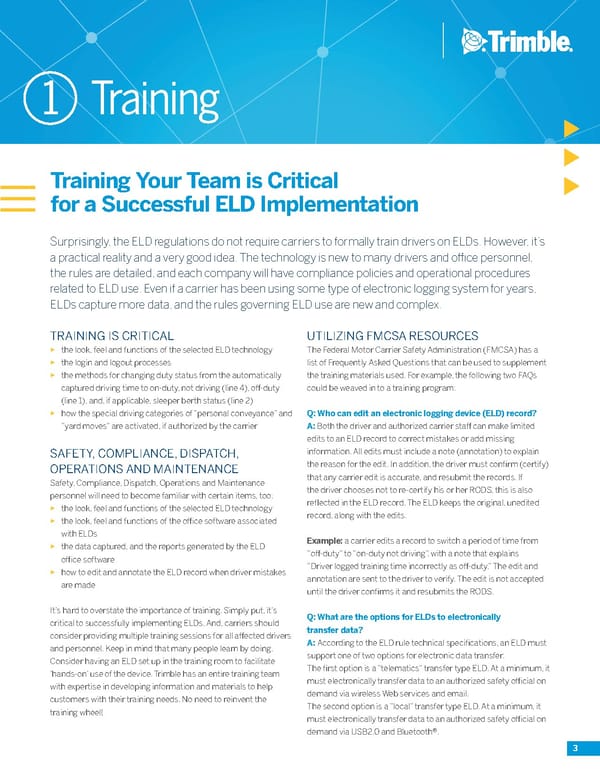3 Surprisingly, the ELD regulations do not require carriers to formally train drivers on ELDs. However, it’s a practical reality and a very good idea. The technology is new to many drivers and office personnel, the rules are detailed, and each company will have compliance policies and operational procedures related to ELD use. Even if a carrier has been using some type of electronic logging system for years, ELDs capture more data, and the rules governing ELD use are new and complex. Training Your Team is Critical for a Successful ELD Implementation TRAINING IS CRITICAL ► the look, feel and functions of the selected ELD technology ► the login and logout processes ► the methods for changing duty status from the automatically captured driving time to on-duty, not driving (line 4), off-duty (line 1), and, if applicable, sleeper berth status (line 2) ► how the special driving categories of “personal conveyance” and “yard moves” are activated, if authorized by the carrier SAFETY, COMPLIANCE, DISPATCH, OPERATIONS AND MAINTENANCE Safety, Compliance, Dispatch, Operations and Maintenance personnel will need to become familiar with certain items, too: ► the look, feel and functions of the selected ELD technology ► the look, feel and functions of the office software associated with ELDs ► the data captured, and the reports generated by the ELD office software ► how to edit and annotate the ELD record when driver mistakes are made It’s hard to overstate the importance of training. Simply put, it’s critical to successfully implementing ELDs. And, carriers should consider providing multiple training sessions for all affected drivers and personnel. Keep in mind that many people learn by doing. Consider having an ELD set up in the training room to facilitate ‘hands-on’ use of the device. Trimble has an entire training team with expertise in developing information and materials to help customers with their training needs. No need to reinvent the training wheel! UTILIZING FMCSA RESOURCES The Federal Motor Carrier Safety Administration (FMCSA) has a list of Frequently Asked Questions that can be used to supplement the training materials used. For example, the following two FAQs could be weaved in to a training program: Q: Who can edit an electronic logging device (ELD) record? A: Both the driver and authorized carrier staff can make limited edits to an ELD record to correct mistakes or add missing information. All edits must include a note (annotation) to explain the reason for the edit. In addition, the driver must confirm (certify) that any carrier edit is accurate, and resubmit the records. If the driver chooses not to re-certify his or her RODS, this is also reflected in the ELD record. The ELD keeps the original, unedited record, along with the edits. Example: a carrier edits a record to switch a period of time from “off-duty” to “on-duty not driving”, with a note that explains “Driver logged training time incorrectly as off-duty.” The edit and annotation are sent to the driver to verify. The edit is not accepted until the driver confirms it and resubmits the RODS. Q: What are the options for ELDs to electronically transfer data? A: According to the ELD rule technical specifications, an ELD must support one of two options for electronic data transfer: The first option is a “telematics” transfer type ELD. At a minimum, it must electronically transfer data to an authorized safety official on demand via wireless Web services and email. The second option is a “local” transfer type ELD. At a minimum, it must electronically transfer data to an authorized safety official on demand via USB2.0 and Bluetooth®. 1 Training
 Roadmap to the ELD Mandate Page 2 Page 4
Roadmap to the ELD Mandate Page 2 Page 4